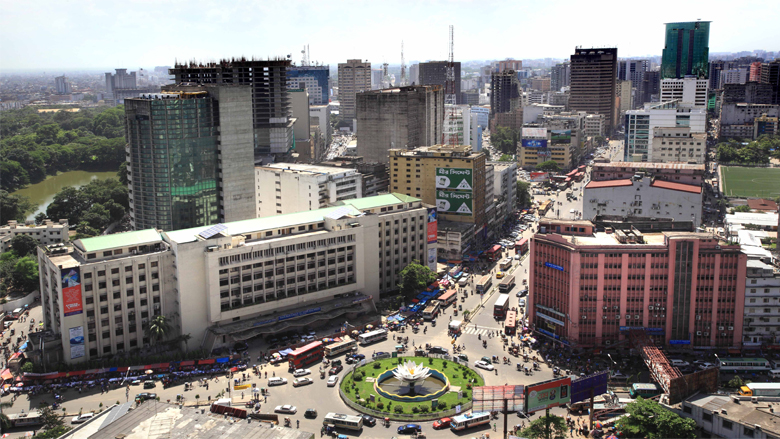Bangladesh's economy is on a stable path with a positive near-term macroeconomic outlook. The latest Bangladesh Development Update notes declining inflation, rising reserves, contained fiscal deficit and stable public debt. Downside risk persists for the economy regarding both domestic and external factors. International competitiveness on both demand and supply sides show a declining trend. Headcount poverty based on PPP US$ 1.25 per day is projected to have declined from 43.5 percent in 2010 to 38.4 percent in 2015. Bangladesh needs to sustain Gross Domestic Product (GDP) and remittances growth, create jobs, contain inflation, and improve the quality of public service delivery to reduce extreme poverty and boost shared prosperity.
Growth momentum regained with political stability. FY15 GDP growth is estimated at 6.5 percent. This could not have accounted for losses due to political disruptions and there is some disconnect with proxy indicators like private credit, NBR revenue growth and imports. Export growth declined to 3.4 percent. However, remittance growth recovered to 7.7 percent. Rise in industrial growth to 9.6 percent in FY15 from 8.2 percent in FY14 propelled growth. Though, growth in consumption dominated, the real private investment growth declined. Agriculture growth is slower and the private investment rate is stagnant.
Inflation declined to 6.4 percent in FY15 from 7.3 percent in FY14, thanks to declining food inflation. The rural-urban gap in food inflation also reduced. But, non-food inflation increased as political unrest caused supply disruptions. Aggregate demand management limited inflation volatility while declining international commodity prices helped reduce inflation.
Despite current account deficit, balance of payment surplus amounted to about $4.4 billion in FY15 compared to $5.5 billion in FY14, thus sustaining the appreciation pressure on the nominal exchange rate. Foreign exchange reserve growth continues. Increased trade deficit from $6.8 billion in FY14 to $9.9 billion in FY15 reflects eroding external competitiveness. The period witnessed weak export growth andstrongimport growth. Despite remittance recovery, the current account went into a deficit of $1.65 billion, compared to $1.4 billion surplus in FY14. The Bangladesh Bank interventions perpetuated foreign exchange reserve build up, exceeding $25 billion by end-June 2015.
Monetary management on track with feeble domestic credit growth: Declining inflation, reduced lending rates, stable exchange rate and reserve build up show the central bank’s monetary policy worked well. 12.4 percent broad money growth in FY15 languished below the Monetary Policy Statement target of 16.5 percent, primarily due to a 10% domestic credit growth shortfall compared to 20.2% target. It reflects weak credit demand from private sector and the government. Net foreign assets grew by 18.2%, compared with FY15 3.6% target. The banking sector face challenges with estimated average earning decline by 7 percent in FY15 vis-à-vis 7.5 percent growth in FY14.
Overall fiscal deficit was contained at 3.6 percent of GDP, despite low tax collections due to political disruptions, and a shift towards low duty commodity import. NBR revenue collection fell short, at Tk. 1208.2 billion in FY15 compared to Tk. 1497.2 billion target. The Annual Development Program (ADP) implementation lags behind with an out turn of Tk 685 billion, though improved from last year. Domestic financing of budget deficit increased to 1.4 percent of GDP in FY15 from 1.1 percent in FY14. This came entirely from 93 percent increase in non-bank borrowing.
Pace of structural reforms is slow with delays in implementing IMF programreforms. Implementation of United States Trade Representative Action Plan show impressive progress but not completed yet. Hence, Bangladesh was not in the list of122 GSP eligible countries, renewed in July 15.
Macroeconomic outlook seems positive with moderate, uneven global growth at 3.1 percent in 2015 and 3.6 percent in 2016.
FY16 budget is more of the same as FY15, implementation remains the main challenge. Revenue and foreign financing targets are ambitious. ADP is oversized with too many projects. Spending on subsidy is projected to decline further.
Growth in FY16 is projected at 6.5 percent backed by stronger consumption and export growth. Public sector wage increase may add 0.9 percentage point to the measured growth.
Macroeconomic stability expected to sustain in FY16. However, reducing inflation to 6.2 percent during FY16 will be challenging but achievable given a cautious 15.6% broad money growth and stable international prices. External current account deficit is projected at 0.4% of GDP, but reserve increase may continue. Budget deficit in FY16 is likely to increase to 4.6 percent of GDP as revenue collections fall short of the ambitious revenue targets and exceed expenditure shortfall. Debt is currently at a low risk of distress.
External and domestic risks loom large. China’s economic transformation, fall in commodity prices, elusive increase in U.S. interest rates and increased geopolitical tension in Middle East, Ukraine or Africa may affect growth. Prolonged slower growth in the advanced and emerging markets may adversely impact the garments exports and widen trade deficit. The Trans-Pacific Partnership might pose further threat for Bangladeshi RMG products in the US in the medium-term. Public insecurity, political uncertainty and tightening of supply side constraints can also hurt growth prospects. Financial sector vulnerability includes increase in non-performing loans to total loans, problematic corporate governance in banking, and restricted access to credit for doing business.
Way forward:
Policy makers should plan to tackle macro slippages such as the large current account deficit, exchange rate volatility and rising inflation. They should strive to stem financial sector insolvency and prioritize the completion of ongoing reform initiatives.

